In Bid for Cleaner Water, California Seeks Arranged Utility Marriages
Uniting small, failing utilities with larger neighbors can fix water problems.
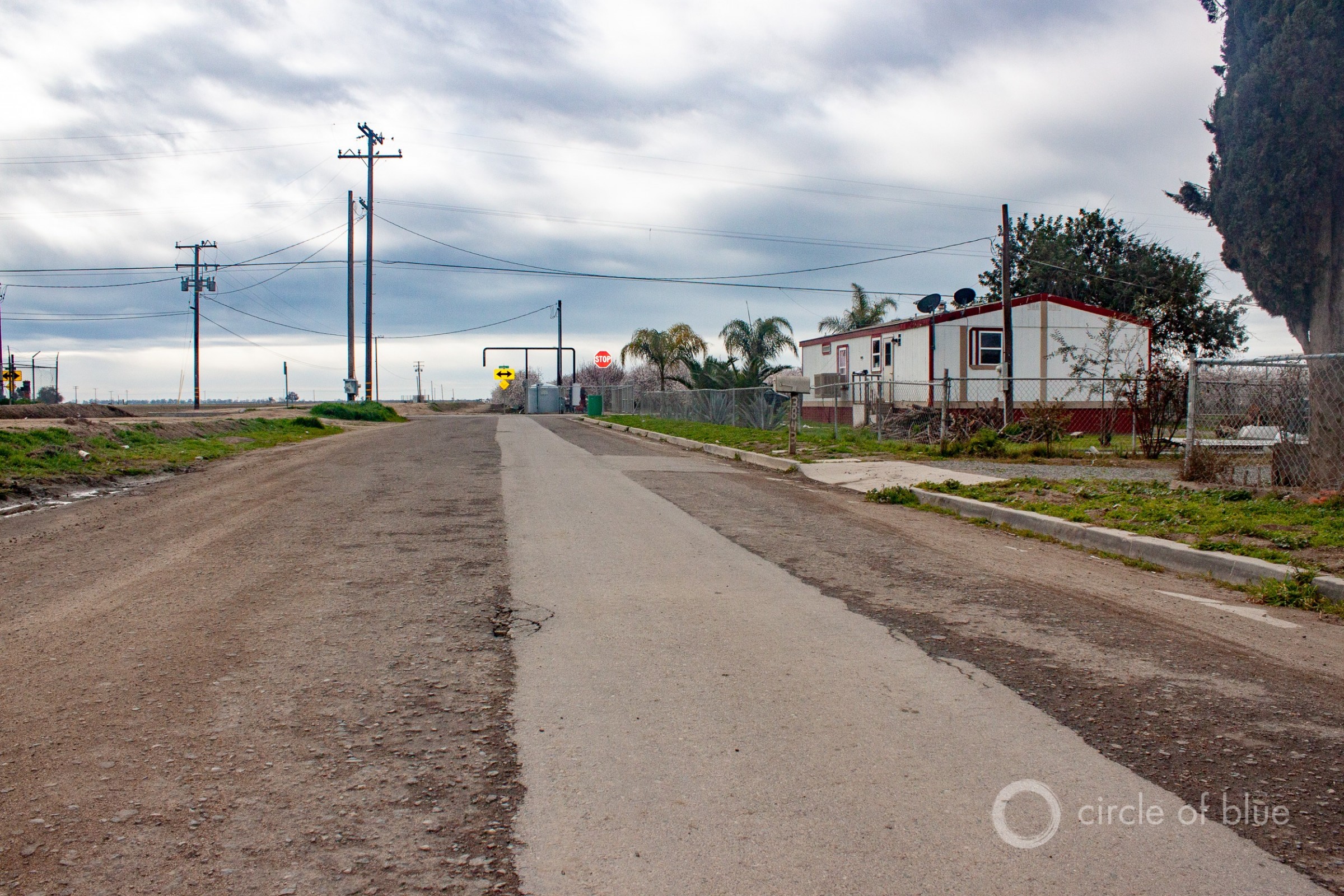
A fresh strip of pavement on a street in Matheny Tract, an unincorporated community in California’s San Joaquin Valley, is evidence of a newly installed water distribution pipe. Matheny Tract was connected to the city of Tulare’s water system in 2016. Photo © Brett Walton/Circle of Blue
By Brett Walton, Circle of Blue
BAKERSFIELD, Ca. — Michael Salazar, in his mid-fifties and on government disability, is the reluctant president of South Kern Mutual Water Company. The tiny nonprofit enterprise supplies drinking water from a single well tainted by toxic substances to 15 homes in an unincorporated community just outside this city’s southern boundary, where almond orchards unfurl toward the horizon.
The outgoing president, Sherry Settlemoir, who lives across the street, stepped down at the beginning of 2018 because the duties of the troubled water company were overwhelming. She had to file regulatory paperwork and administrative reports, collect bills, do basic maintenance, and pay contractors. Besides, she has an ill father in Oklahoma to take care of. “My dad’s more important than this water system,” Settlemoir, frustration swelling in her voice, told Circle of Blue.
Salazar did not want the unpaid job. No he did not. But he felt as if he had no choice. No one else in the community volunteered for the position, which included dealing with polluted water. Neither South Kern’s system nor neighboring Old River’s water system, which together serve 30 homes, could shoulder the cost of a new treatment unit.
In 2015, California lawmakers passed a measure intended to resolve just this kind of impasse. Under Senate Bill 88, the State Water Board was given the power to force a larger, better run utility to absorb a smaller neighbor that consistently fails to deliver clean water. Salazar and Settlemoir are in favor. They would like South Kern to connect to Bakersfield’s system, which serves high-quality water to 144,000 people.
The State Water Board, which regulates drinking water systems, wants the merger. It’s the easiest, cheapest way to improve water service to the two communities, state officials say. Bakersfield objects, though, arguing that the engineering logistics are more complex than laying a mile of pipe.
The three sides have been in negotiations for two and a half years, a struggle between one of the largest cities in California’s Central Valley, state officials, and two tiny water suppliers that is the first significant test of the four-year-old statute.
“We’re trying to take the lead in California on consolidation,” said Darrin Polhemus, director of California’s Division of Drinking Water.
Amid rising costs, stricter regulations, deteriorating water quality, and a lack of technical expertise, many small water systems in California and across the country are looking to join forces with larger systems, either through sharing operations staff, forming regional partnerships, or full integration of the physical infrastructure, governance, and billing systems.
So called “consolidations” won’t solve all of America’s drinking water problems, said Jeff Hughes, director of the University of North Carolina’s Environmental Finance Center, who has studied utility financial struggles across the United States.
But they are a tool, and one that is in demand. “We’ve worked in many areas where people are saying, ‘Please take over our system,’” Hughes told Circle of Blue. “The change is the cost of running these systems, particularly in places with population losses. They don’t see a way of it getting better.”
Less enthused is the rural water lobby, which thinks consolidations are an option worth investigating, but only if smaller entities are not coerced into a marriage that they do not want or higher bills that they cannot pay.
“A better method is to look at what the community wants and what the risks are,” said Mike Keegan, policy analyst with the National Rural Water Association.
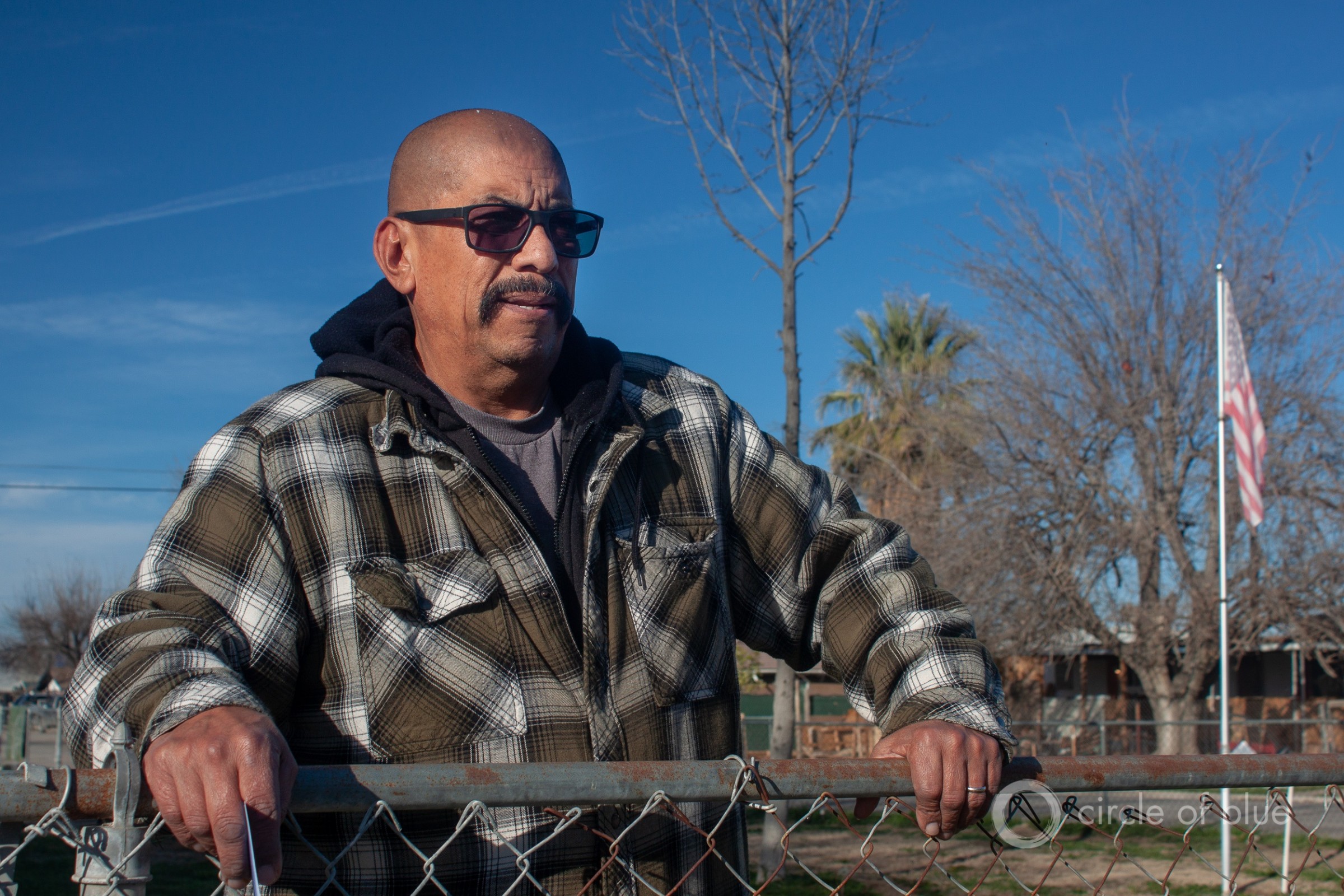
Michael Salazar is the reluctant president of South Kern Mutual Water Company. He volunteered for the unpaid position only because no one else in his community wanted to do it. Photo © Brett Walton/Circle of Blue
Go For It
Michael Salazar considers the risk worth it. With no training or experience, Salazar reluctantly offered to fill the president role for South Kern because he didn’t want to pay an outside contractor to do all the administrative tasks. Outsourcing the work would result in a higher monthly bill, he said.
That was just a start. Simply paying the bills on time has been problematic. McMor, the contractor that checks disinfectant levels in the system’s well and collects samples for lab analysis, did not receive payment from South Kern for three months last summer and had no contact with Salazar. Since then, the bills were repaid.
On top of management lapses like that, South Kern serves bad water. The company’s well for several years has exceeded the federal standard for uranium, which is naturally present below ground. Its water also violates the new state standard for 1,2,3-TCP, a grease remover that is used in manufacturing pesticides and is found in groundwater throughout California’s Central Valley. The State Water Board issued a compliance order to South Kern for uranium in 2016 and 1,2,3-TCP last year.
Paying out of pocket for a treatment unit would be a burden for residents of South Kern, where the median household income of $31,669 is less than half the state figure.
Administrative struggles, financial difficulties, and polluted water were just too much for Settlemoir. Same for Salazar. Both would love for South Kern, along with Old River Mutual Water Company, a system about the same size and just down the road, to connect to the city of Bakersfield, whose distribution network ends about a mile away.
“It would be a big help,” Salazar told Circle of Blue.
Mergers and Acquisitions
Survival for small utilities is tough. The United States has more than 50,000 community water systems, defined as those that serve at least 15 connections. It’s an enormous number, and a relic of past development patterns. The largest systems, like the Los Angeles Department of Water and Power, distribute water to millions of people. But large water utilities are the minority.
If electric providers are the top predators of the utility ecosystem — large in size and few in number — then water systems are the insects, startling in their number and diversity. California counts 75 electric utilities in the state and 900 wastewater districts — but 7,439 public water systems.
There are thousands of entities like South Kern that deliver water to only hundreds or dozens of people. Small systems are also some of the most frequent violators of state and federal drinking water standards.
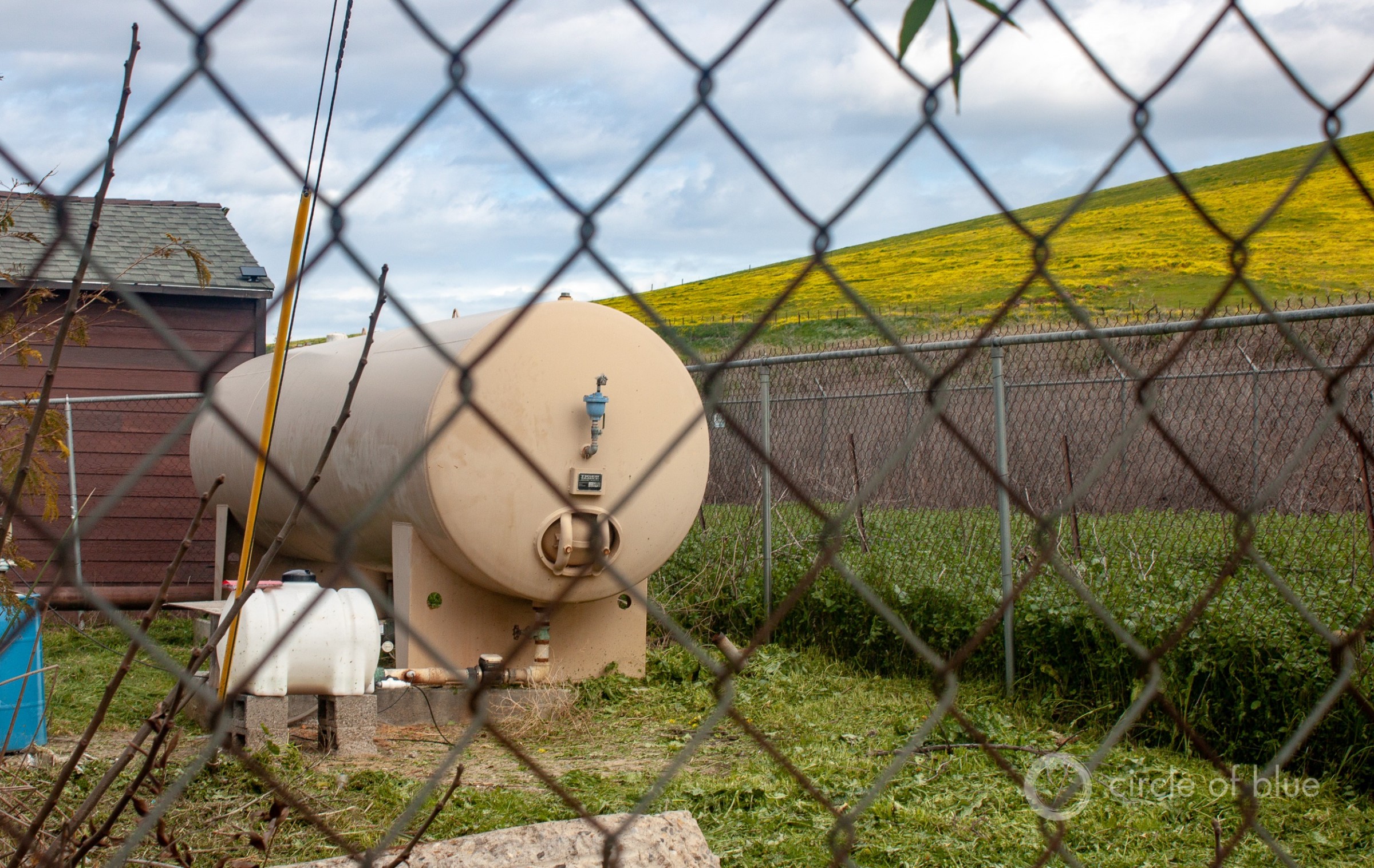
The well that serves about 80 homes in the unincorporated community of Tooleville, on the east side of Exeter, in California’s San Joaquin Valley. Tooleville residents would like to join Exeter’s water system. Photo © Brett Walton/Circle of Blue
In many cases the water they serve is tainted. Sixty years ago a community in California could drill a well and generally find sweet water. Today, groundwater throughout the Central Valley is laced with the residues of the state’s industrial past and present: nitrates from fertilizers and solvents from manufacturing, as well as naturally occurring arsenic and uranium.
Polhemus and others at the Water Board worked for years to build up the capacity of operators to manage and maintain small systems. But in reviewing the results, they discovered that water quality trends are persistently stubborn. The people they trained might have moved or found new jobs and taken their state-funded knowledge with them.
The trend, decades in the making, is solving the challenges of size and staffing with consolidation. The number of community water systems in the country has declined by almost 1,000 in the last five years and nearly 4,000 since the year 2000. The number of utilities, Hughes points out, is even lower since investor-owned water companies may operate hundreds of individual systems.
Polhemus now has a new strategic direction: to reduce the number of systems in California. The authority in Senate Bill 88 has helped, largely because he has two additional staff members to assist communities that want to explore voluntary consolidation, which state officials prefer over mandatory enforcement. In the last two years, roughly 100 voluntary consolidations have been completed. “The number is trending in the right direction, but not fast enough,” he told Circle of Blue.
Size has consequences. The smallest systems, those serving fewer than 500 connections, account for more than 90 percent of the drinking water violations in the state, Polhemus said.
Supporting California’s consolidation power is an odd coalition: policy wonks, who look at the economic and demographic trends and understand that the numbers just don’t add up for a lot of small communities; social justice advocates, who see a lifeline for poor communities that have been saddled with foul water for years; and private water companies, which are hungry for business growth, new customers, and the revenue that comes with them.
Before California passed Senate Bill 88, Kentucky lawmakers, in 2000, made it a state goal to consolidate water and sewer systems. The state has spent at least $398 million to shepherd dozens of projects to completion.
“That funding spurred these systems to start talking to one another,” Donna McNeil, executive director of the Kentucky Infrastructure Authority, told Circle of Blue. “Without grant money to seed that conversation, even if it was being leveraged with loans or other federal funding, I don’t think that the consolidation effort would have gotten off the ground as well.”
Consolidation has attracted attention in the corridors of power and in board rooms. America’s Water Infrastructure Act, a wide-ranging bill with near-unanimous support in Congress, was signed by President Trump last October. The bill authorized states and the Environmental Protection Agency to require that non-compliant water systems explore consolidation. The bill’s language does not grant the power to require the next step and actually merge, but other details are still being worked out. The EPA is in the process of writing regulations to implement the law, an agency spokesman said.
Keegan said he thinks the bill’s language, which requires a consolidation assessment only if violations “are likely to adversely affect human health,” is vague enough that it will be difficult to act on.
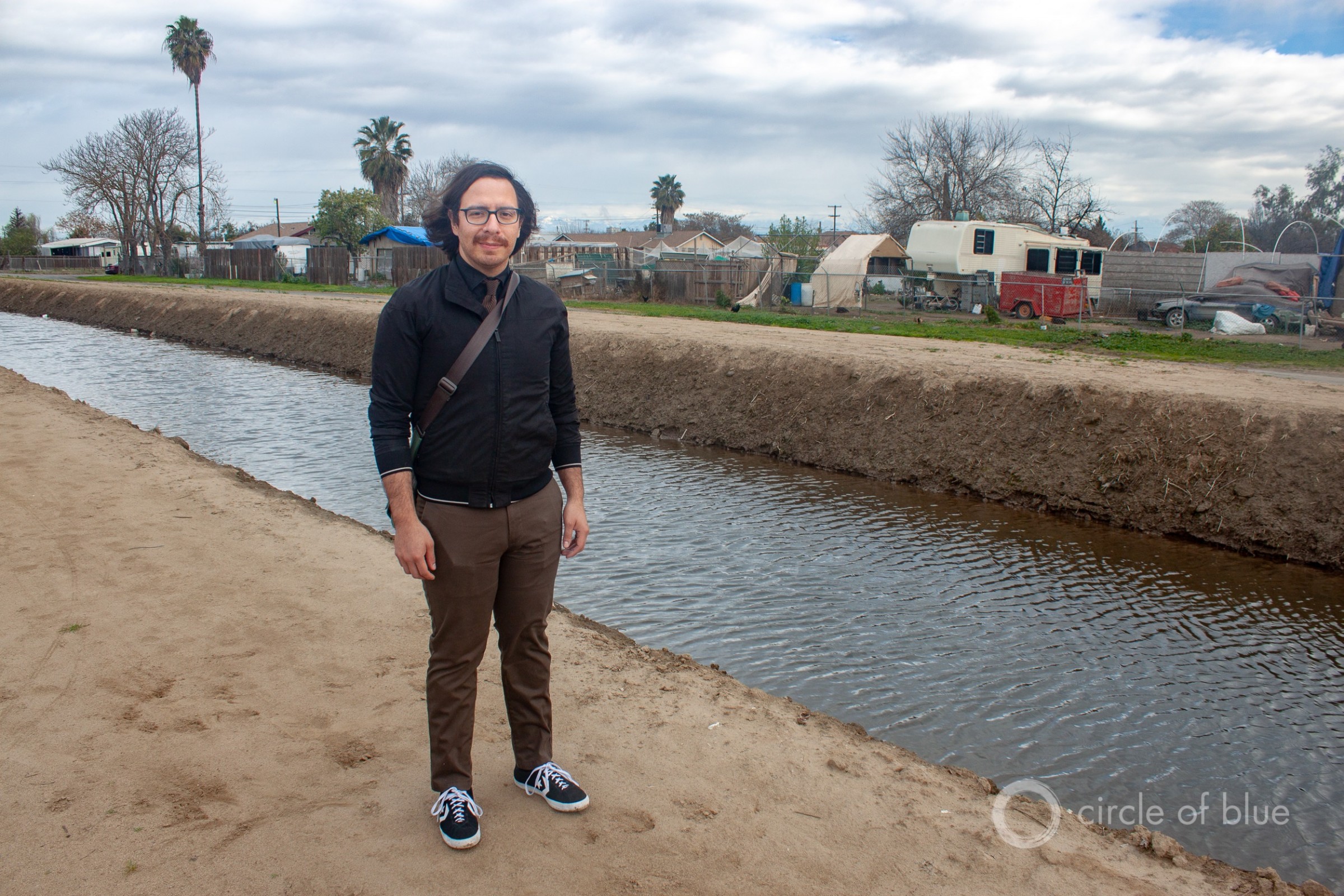
Pedro Hernandez stands next to a canal that cuts through the unincorporated community of Matheny Tract. A policy advocate for Leadership Council, Hernandez worked on the campaign to connect Matheny Tract’s water system to the city of Tulare. Photo © Brett Walton/Circle of Blue
Investor-owned water companies, meanwhile, are also energized by the prospect of more consolidation, which they view as an opportunity for business growth. Executives at American Water, the largest publically traded U.S. water company, noted the America’s Water Infrastructure Act consolidation provision in their third-quarter and fourth-quarter 2018 earnings calls.
“The result of this law is policies that set a course for enhanced water compliance and improved management for water systems across the country. All of these efforts” — including state laws in California and elsewhere — “help our company provide solutions to water and wastewater challenges across our footprint,” said Walter Lynch, American Water’s chief operating officer, said on the February 20 call.
‘It’s Tough for These Small Systems’
Michael Salazar and the South Kern Mutual Water Company have a useful model to emulate north of Bakersfield with the Oildale Mutual Water Company. A mutual water company is a not-for-profit organization that supplies water to those living in its service area at cost.
Oildale, founded a century ago, supplies about 35,000 people. As it expanded, consolidation became an attractive option for smaller mutual water companies in its path that were dealing with contaminated water sources. The most recent consolidation, a voluntary union completed about 15 years ago, was with Seventh Standard, a mutual water company to the west of Oildale. Seventh Standard’s well water, which served about two dozen homes, was above the state limit for nitrate.
“As we grew around them, they pretty much requested us to integrate, consolidate with them,” Doug Nunneley, Oildale’s general manager, told Circle of Blue. “Even before they were forced to, because of water quality.”
The Seventh Standard example is instructive. It illustrates three pivotal points in the consolidation discussion.
First is proximity. Seventh Standard was about a mile from Oildale’s distribution system, which held down the construction cost. The more remote a community is, the more expensive it is to connect.
Polhemus said that the State Water Board ran an analysis of how many systems with water that does not meet state and federal standards could be fixed through consolidation, based on proximity to a larger utility. A quarter of the chronic violators were within a half mile of a larger system’s distribution network, and one third were within one mile. Polhemus calls those the “low-hanging fruit.”
The second point is that relationships matter. Consolidations can be a merger of unequals. Utilities fear the loss of local control over rates and rules. Social dynamics as seemingly trivial as high school football rivalries may bleed into consolidation discussions. Residents who live in unincorporated areas may not be accustomed to city watering restrictions and they may worry about the encroachment of other city rules unrelated to water service. Many of the residents served by mutual water companies in unincorporated Central Valley communities keep horses, chickens, and livestock on their property.
Consolidation can be a very good thing, but it can be expensive.” Doug Nunneley, Oildale Mutual
The third lesson is that often the success of these consolidations relies on outside funding. Senate Bill 88, the law that authorized mandatory consolidations, requires that there be no construction cost to the smaller community, which has to be economically disadvantaged to qualify, and the state has a pool of money that it can tap for that purpose.
Most full consolidations require an upfront investment that can be several million dollars, Hughes said. The tradeoff is that better water will be available down the road, but only after new debts and assets are built.
Even in Seventh Standard, which was not an economically disadvantaged community, paying for the $2 million project themselves was out of the question. Without a state grant, the construction cost would have amounted to about $80,000 per home.
“Consolidation can be a very good thing, but it can be expensive,” Nunneley said. “Like I say, a couple million dollars just to tie the systems together. Without that grant, on the cost per home, no way they could afford it.”
Mandatory Consolidation
But money, as it turns out, is not everything.
State funding is available to pay the cost of connecting South Kern and Old River to Bakersfield’s distribution network. In addition, Bakersfield can access $10 million in no-interest loans for other improvements to its water system. Still, no deal has been reached.
“It blows my mind,” Polhemus said. “Money is not what they’re concerned about.”
What they are concerned about, according to Chris Huot, the assistant city manager, are logistics and coordination. The city does not want to run a one-way pipe to the communities, which would increase maintenance costs because it would need to be flushed. The city prefers a looped system, where the water could flow freely, but that would increase the construction cost and require coordination with plans to upgrade a state highway that fronts the two communities.

Chris Huot, left, Bakersfield’s assistant city manager, gestures at a map of the city. The two communities that the State Water Board would like to merge with Bakersfield’s water system are just south of the city limit. Art Chianello, the water resources manager, looks on. Photo © Brett Walton/Circle of Blue
“I don’t think these consolidations are a one-size-fits-all model,” Huot told Circle of Blue. “In this case, there would need to be engineering study work and analysis, right of way acquisition, significant infrastructure upgrades within the neighborhoods. Those neighborhoods do not have sidewalks or storm drains, curb and gutter. Pretty much any other time that city uses state and federal funds there are requirements to bring other things up to code.”
The Water Board’s response is that it is only authorized to provide funds for water infrastructure, not for upgrading the sidewalks.
Social justice campaigners are critical of the State Water Board’s slow pace in general on consolidations. The board is using its mandatory authority “very selectively and very cautiously,” said Pedro Hernandez, a policy advocate at Leadership Counsel, which works on social issues in the San Joaquin Valley.
Hernandez was an organizer in the state’s first application of its mandatory authority, in a community called Matheny Tract, outside of Tulare. That consolidation, which was on track voluntarily before needing a push from state regulators across the finish line, was completed in 2016.
Matheny Tract residents are pleased with the new arrangement, Hernandez said. But they had to adjust to having their water use metered for the first time.
South Kern residents, meanwhile, wait for the day that they can rid themselves of their water system and connect with Bakersfield.
“It can’t happen soon enough,” said Settlemoir, who does not drink her tap water.
This report was made possible in part by the Fund for Environmental Journalism of the Society of Environmental Journalists.
Brett writes about agriculture, energy, infrastructure, and the politics and economics of water in the United States. He also writes the Federal Water Tap, Circle of Blue’s weekly digest of U.S. government water news. He is the winner of two Society of Environmental Journalists reporting awards, one of the top honors in American environmental journalism: first place for explanatory reporting for a series on septic system pollution in the United States(2016) and third place for beat reporting in a small market (2014). He received the Sierra Club’s Distinguished Service Award in 2018. Brett lives in Seattle, where he hikes the mountains and bakes pies. Contact Brett Walton

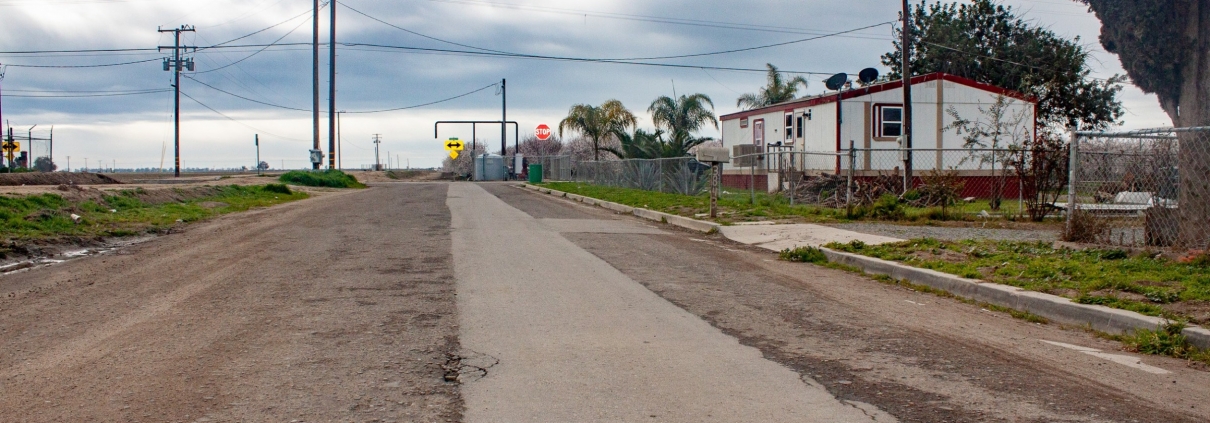



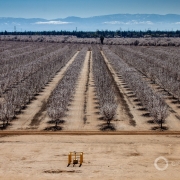



Thank goodness for people like Sherry and Michael. Unsung heros in the pursuit of clean water for their neighbourhood and wider community. It’s people like them who make a real difference in the world. Bless.